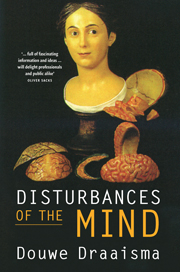Book contents
- Frontmatter
- Contents
- Introduction
- 1 Towards dusk the images appear
- 2 A tormenting round of tremors
- 3 Phineas Gage’s posthumous stroll
- 4 The Celestine prophesy
- 5 Sparks from a Leyden jar
- 6 Siberian brandy
- 7 Go to hell, idiot! Gilles de la Tourette syndrome
- 8 A labyrinth of tangles
- 9 The Mercator of neurology
- 10 The headquarters of madness
- 11 A cup of tea for the doppelgänger
- 12 Little professors
- 13 The Cardan suspension of science
- Index
- References
7 - Go to hell, idiot! Gilles de la Tourette syndrome
Published online by Cambridge University Press: 05 March 2014
- Frontmatter
- Contents
- Introduction
- 1 Towards dusk the images appear
- 2 A tormenting round of tremors
- 3 Phineas Gage’s posthumous stroll
- 4 The Celestine prophesy
- 5 Sparks from a Leyden jar
- 6 Siberian brandy
- 7 Go to hell, idiot! Gilles de la Tourette syndrome
- 8 A labyrinth of tangles
- 9 The Mercator of neurology
- 10 The headquarters of madness
- 11 A cup of tea for the doppelgänger
- 12 Little professors
- 13 The Cardan suspension of science
- Index
- References
Summary
The year 1893 was an annus horribilis for Georges Gilles de la Tourette. On the night of 15 August, Jean-Martin Charcot died suddenly – the man who had been his master and patron at La Salpêtrière in Paris. The week before, Gilles de la Tourette had visited him in Neuilly, where he had a holiday home. Together they had gone over the proofs of Traité clinique et thérapeutique de l’hystérie, in which Gilles de la Tourette described the insights into the origin and treatment of hysteria which he had gained at La Salpêtrière. The two men had been very close. That same year, Gilles de la Tourette lost his young son Jean to meningitis, while on 6 December he was involved in an incident that could easily have cost him his life.
It was early evening when a woman dressed entirely in black rang the doorbell of his apartment. He was not at home at the time, and his manservant opened the door. She asked to speak to Gilles de la Tourette, and the servant let her in and asked her to wait. Shortly afterwards, when Gilles de la Tourette arrived home, she followed him into his surgery, pulled out a piece of paper bearing the names of the Salpêtrière physicians Luys and Charcot and told him that because of them she was ruined. She then demanded 50 francs. Gilles de la Tourette suggested to the woman, who was clearly disturbed, that it would be better if she were admitted, in his personal care. At this point the woman went into a rage, pulled out a pistol and fired three times. Having thus assured herself a place in the annals of neurology, she sat down again, announcing that she had finally obtained satisfaction – ‘At least one of them has now paid for the others’ – and calmly awaited her arrest.
- Type
- Chapter
- Information
- Disturbances of the Mind , pp. 169 - 198Publisher: Cambridge University PressPrint publication year: 2009
References
- 2
- Cited by



